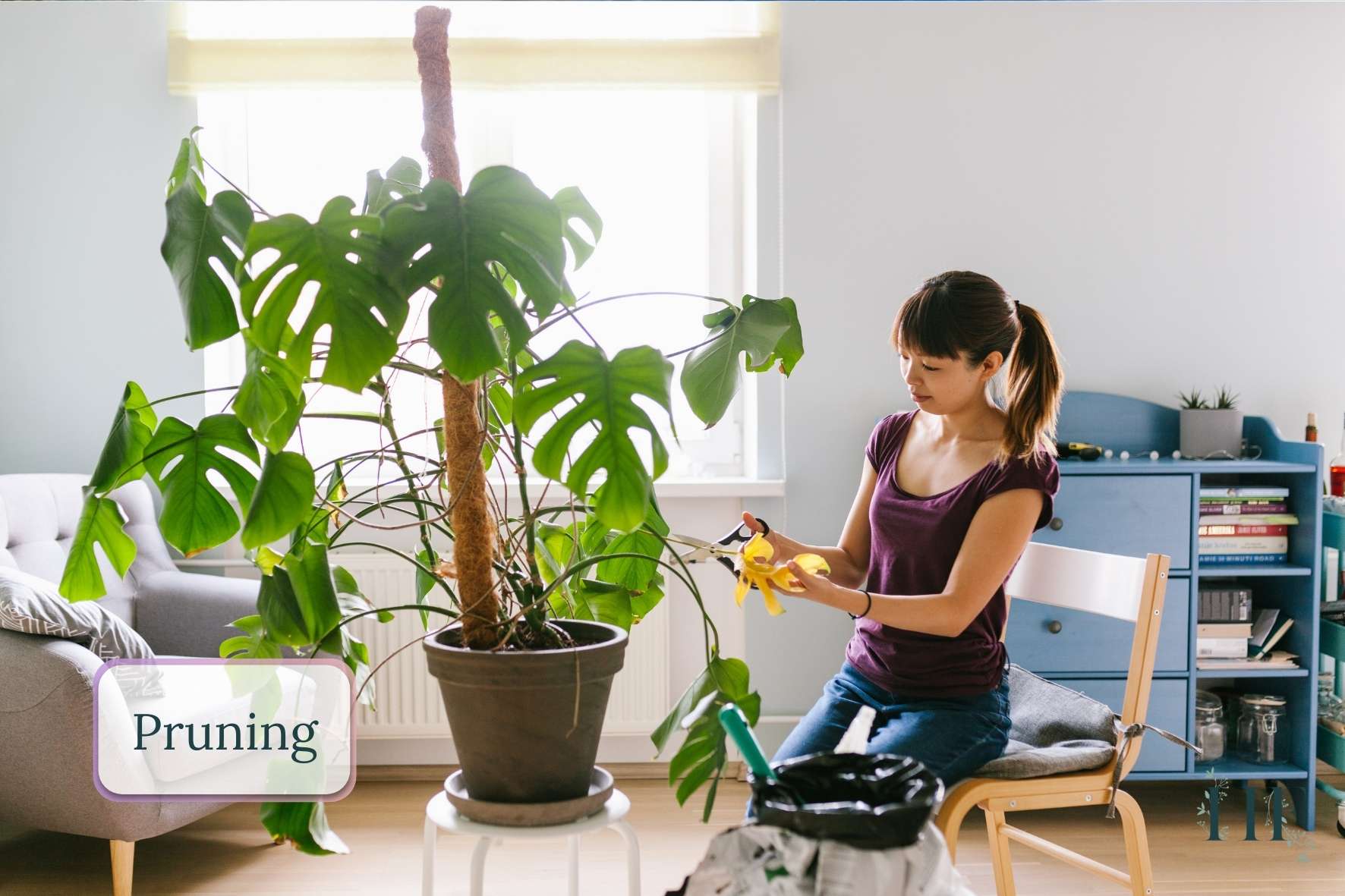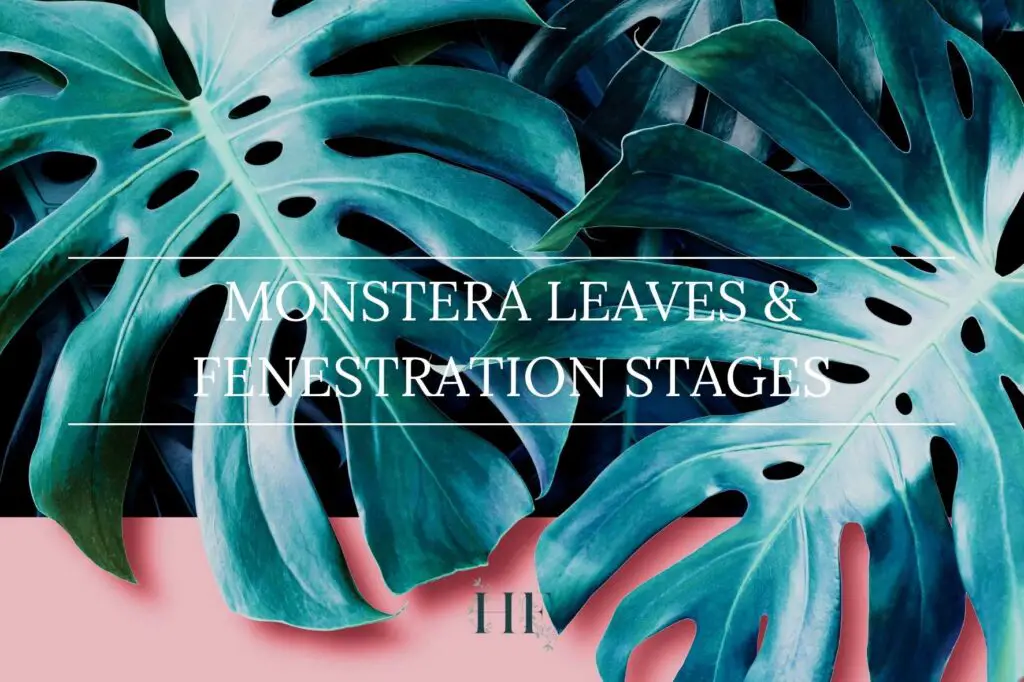Once I bought my Monstera Deliciosa, I couldn’t wait for the day that it would develop gigantic leaves full of splits and holes. I got excited when a few leaves grew fenestrated, however, most of its new leaves were small and had no holes whatsoever.
So, I started wondering… When do monstera leaves split? And what could I do to encourage it to fenestrate? After doing some research, I found my answers.
In this blog post, I will cover everything you need to know about fenestration in Monstera plants. And if you want to help your plant’s leaves split, read until the end to find some useful tips to know what you can do to get your Monstera’s leaves to start fenestrating.
Monstera Leaves FAQ
Let’s start by answering some of the common questions many Monstera plant lovers have:
When Do Monstera Grow New Leaves?
A young Monstera plant grows new leaves every 4 to 6 weeks. However, as the plant ages, the rate of growth will begin to increase too. This is because more nodes exist, therefore more new leaves can be produced.
Monsteras are climbing plants, and as the vine grows, new growth points, called nodes, sprout up. These nodes contain the cells necessary for a new leaf to grow, as well as for new stems to grow.
As these stems grow, more and more nodes are created, and therefore leaves are grown with greater frequency.
What Should New Monstera Leaves Look Like?
The new leaf of a Monstera is bright green and it appears furled (rolled or curled up) in the beginning. Over time, it will grow longer and begin to show more details, such as veins.
As the leaf, still furled, develops you should be able to see if fenestrations are developing on it (more about Monstera fenestration stages and the difference on the leaves further down).
Once the new leaf has reached the right size, it will begin to unravel slowly, a process frequently referred to as unfurling.
During this time, the leave will begin to uncurl, exposing the new growth to more sunlight and allowing you to see its full size and details.
It can take anywhere from 1 to 7 weeks for the leaves of a Monstera to unfurl, which is a natural process and there’s no need to do something about it. In contrast, forcing the unfurling process can damage the new leaf.
Right after unfurling, the leaf will remain thin and bright green. The longer it has been open and exposed to sunlight, the darker and thicker it will get until it eventually begins to look like a mature dark green leaf.
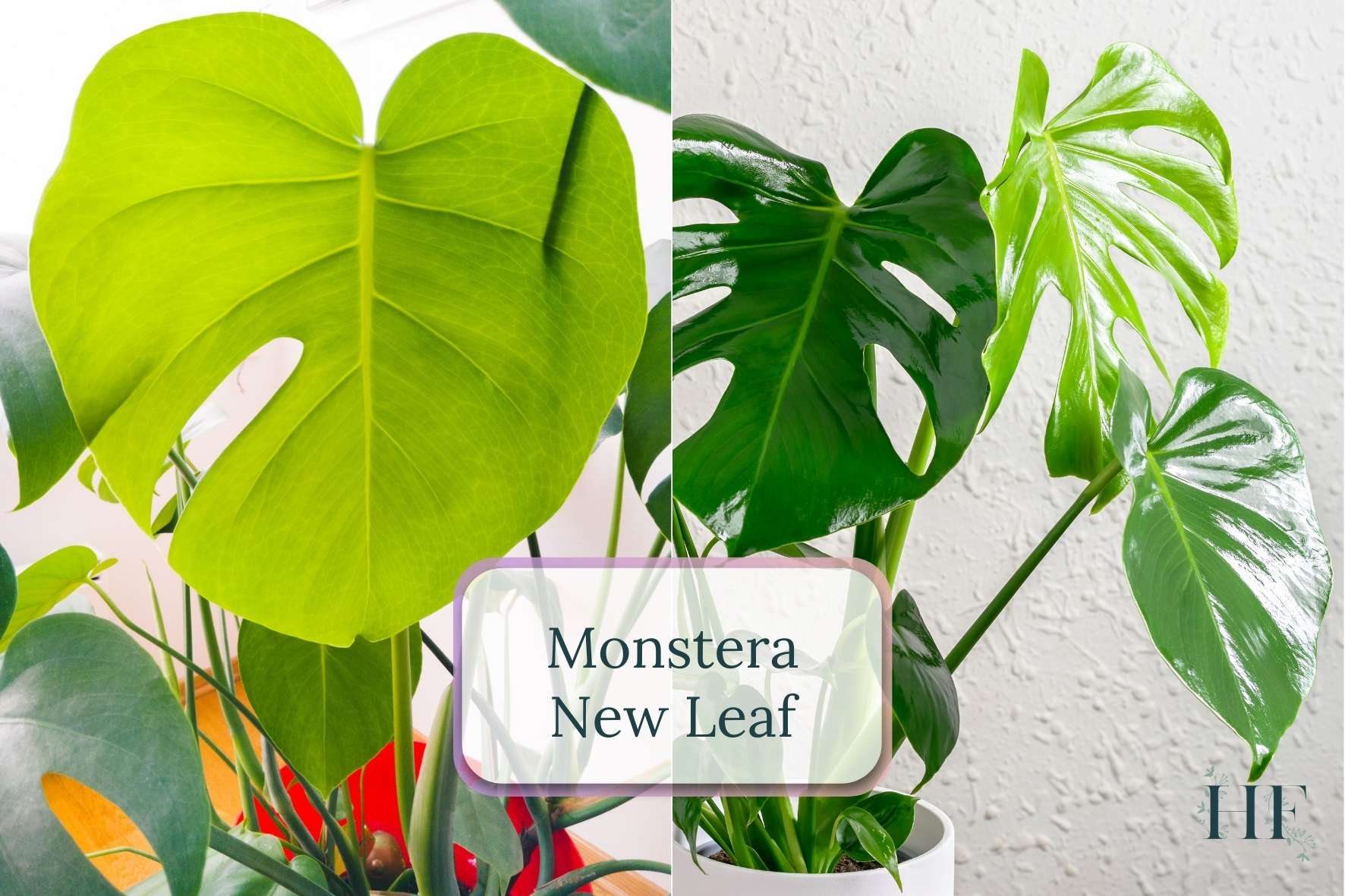
How Long Does It Take for a Monstera Leaf to Unfurl?
The unfurling process can take your Monstera plant anywhere from 1 to 7 weeks.
The factors that contribute to the time it takes for a monstera leaf to unfurl include the environment (humidity levels and sunlight hours), the care routine (watering and feeding frequency), the age of the plant and its health (no pests), and finally the Monstera variety.
Do Leaves Grow Bigger After Unfurling?
Once a Monstera leaf unfurls, it won’t grow bigger. Their development occurs prior to unravelling. Also, the fenestrations will happen before your leaf unfurls.
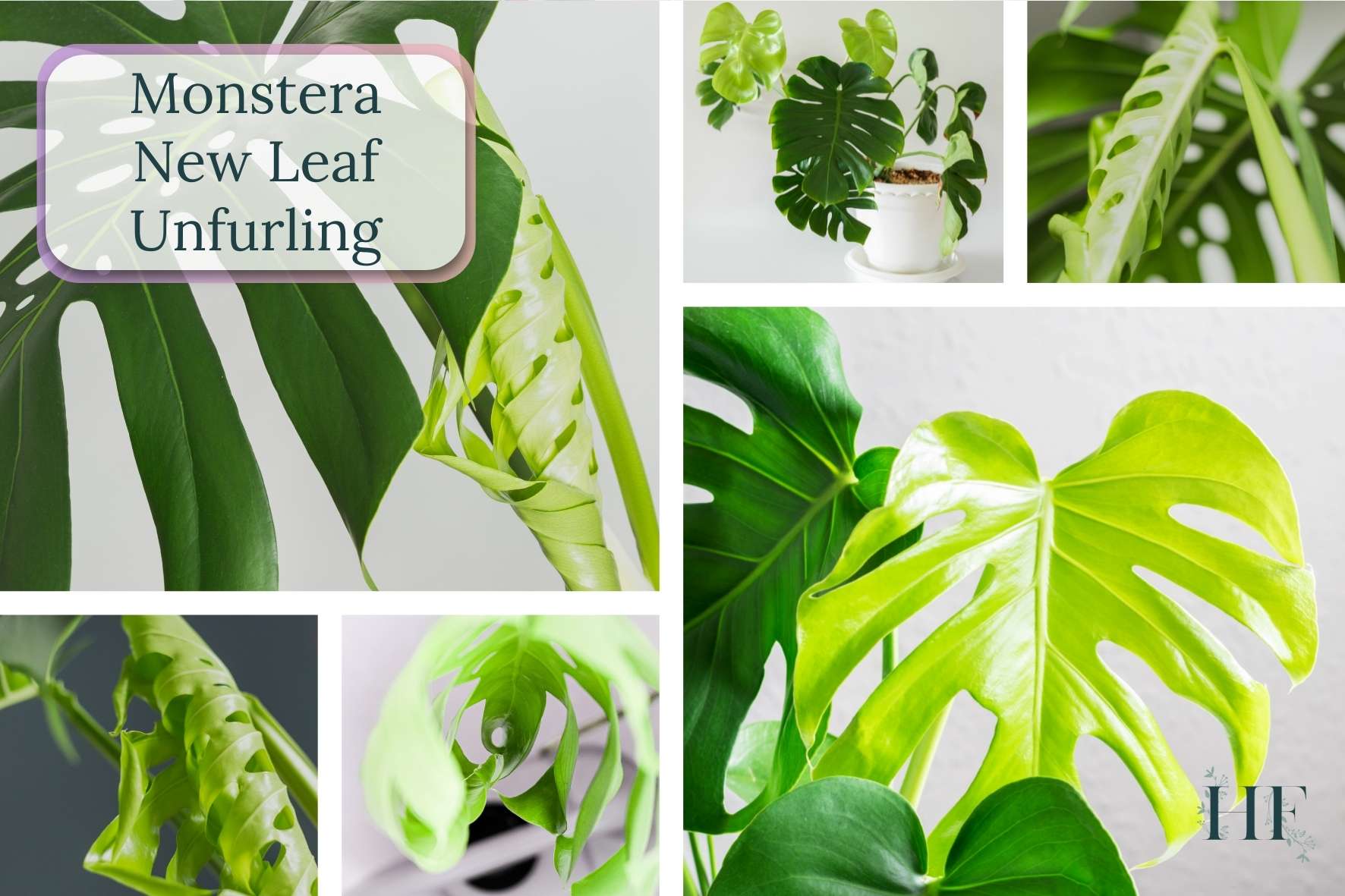
Why Do Monstera Leaves Split?
Monstera Deliciosa plants generally have holes in their leaves to adapt to their natural environment. The 3 main purposes are to capture more sunlight, absorb more water, and withstand harsh winds.
However, light needs remain the more likely explanation for fenestration in Monstera plants.
1) Absorb Sunlight
Monstera grows naturally under the rainforest canopy. The fenestrated leaves allow for the leaves to spread over a greater area to increase their exposure to sunlight. By doing so, Monsteras use less energy to produce and maintain their leaves.
Also, because the huge leaves of mature Monsteras can block sunlight for lower leaves, leaves begin to split to allow sunlight to pass through to lower levels of the plant.
2) Withstand Strong Winds
Again, this all has to do with the natural habitat of Monsteras. The rainforest regions aren’t short of hurricanes.
So, fenestration minimizes the chances of leaves tearing in high winds, letting the air pass through the holes and reducing the impact that strong winds can have on a plant.
But this explanation falls short when you consider the number of plants that call the tropical rainforests their home. Most of them don’t exhibit fenestration, and yet they thrive regardless of strong wind and hurricanes.
3) Improve Access to Water
Fenestration also aids to withstand heavy rainfall, letting the water pass through the holes. Plus, it helps to maximize the amount of rain that’s able to reach the plant’s roots.
But this purpose only makes sense if the tropical rainforests weren’t getting enough rainfall, which is not the case.

When Do Monstera Leaves Split?
To begin with, the characteristics of Monstera leaves depend on the age of the plant and the environment that it’s growing in.
Monstera leaves will typically split between 2 and 3 years of age. Factors like the amount of sunlight, water, humidity, and fertilization need to be taken into account to ensure Monstera develops leaf fenestration.
Insider Tip: My Monstera Deliciosa typically gets its first leaves with splits after 2 to 4 smaller leaves (with no fenestration) form on the same stem. Depending on your growing conditions, the exact number will vary.
When you’re shopping for your new plant, a young Monstera can be identified by its smaller leaves, lack of fenestrations, and fewer nodes and aerial roots. The leaves will often be thinner and a lighter green than older leaves on other plants. Younger plants also tend to be a lot cheaper than older ones.
If you’re purchasing a Monstera that already has fenestrated leaves (a.k.a. leaves with splits and holes), it’s fair to expect that future leaves will have fenestrations too. This is because it shows that the plant has reached the level of maturity it needs to develop fenestration.
How Long Does It Take for Monstera Leaves to Split?
As mentioned above, if you have a young Monstera plant, it generally takes 2 to 3 years before it will start putting out fenestrated leaves.
If you have a mature plant that already has fenestrated leaves, it’s likely that the next new leaves that will appear every 4 to 6 weeks will be fenestrated too.
Note that this is only a guideline. The environment and care practices play a role in the growth of your plant.
Continue reading to find out more about the different Monstera Fenestration Stages and how the leaves change.
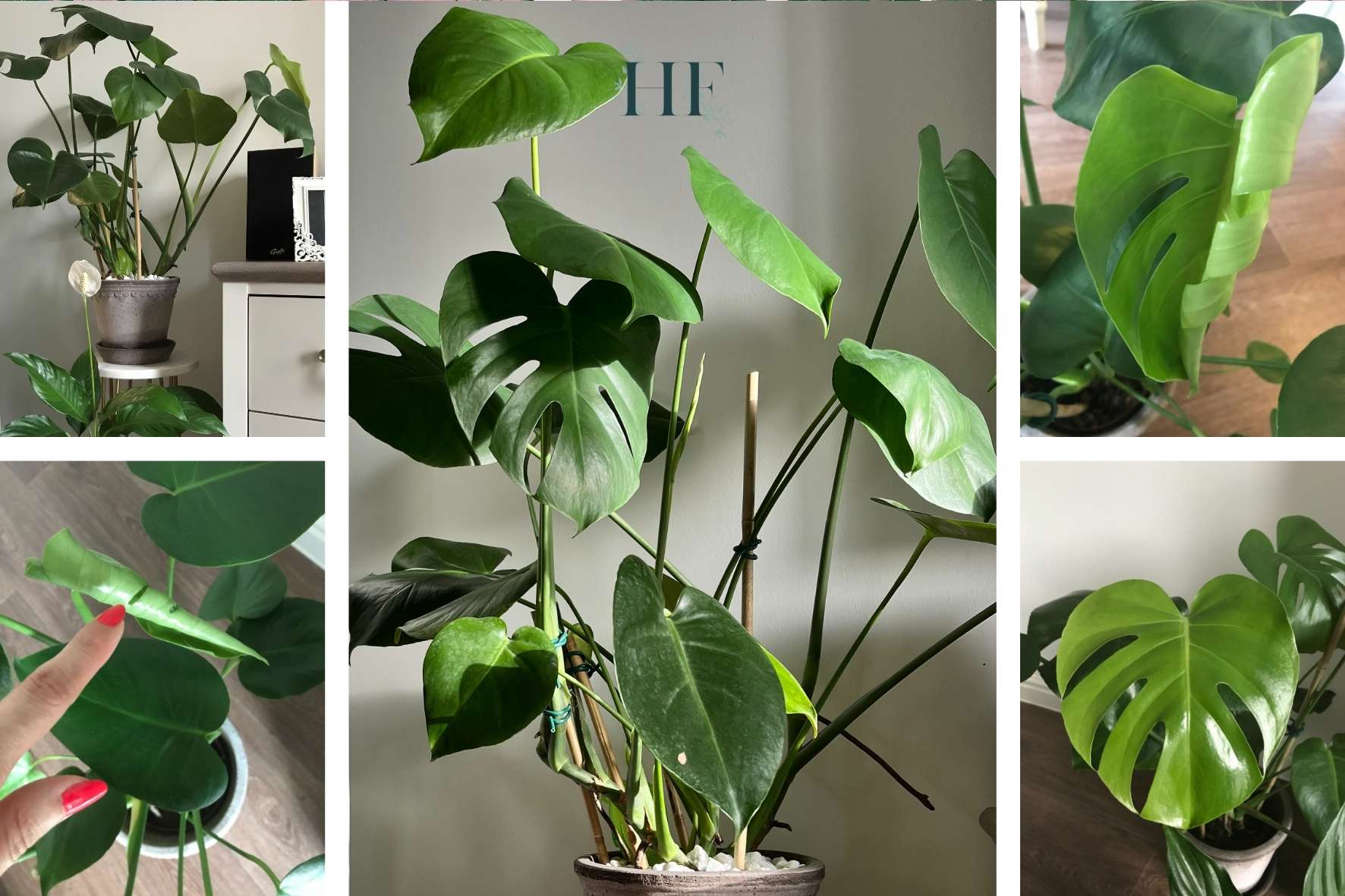
Do Monstera Leaves Split After Unfurling?
Leaves on a Monstera plant will not split after unfurling. The fenestration is already created before the leaves are unfurled, therefore they will not create any more splits or holes after they are unfurled.
Do All Monstera Leaves Split?
Not all Monstera leaves will split. Those that came out when the plant was young will remain unsplit until they wither off.
The fenestration process will begin when a Monstera plant is between 2 and 3 years of age, and even in an older plant, not every leaf will come out fenestrated.
Why Does My Monstera Not Have Holes in the Leaves?
If the leaves of your Monstera aren’t splitting, it usually comes down to two factors: the age of the plant and the volume of available sunlight. A Monstera plant that is too young won’t fenestrate until it is about 2 to 3 years old. Also, lack of sunlight can also prevent mature Monsteras from producing fenestrations.
1) Monstera Is Still Too Young
Age is an essential factor to look at if your monstera leaves are not splitting.
A young Monstera plant will have no holes in them; its leaves are still solid and heart-shaped. They won’t go through the fenestration process until they become 2 to 3 years of age.
So, if your plant is still young, its leaves usually do not have slits. You just need to be patient and continue caring for your plant.
But if you have waited three years and your Monstera shows no signs of fenestration, it’s time to look at your care regimen.
2) Monstera Needs Proper Care
The absence of fenestration on mature Monstera leaves may indicate a lack of light, lack of moisture or lack of nutrition.
So, if you are not seeing any splits when your plant is older than 3 years, it’s definitely time to consider your care regimen and make sure your Monstera is getting:
- Enough indirect sunlight.
- Nutrients – fertilise your plant during the spring and summer months.
- Appropriate humidity levels.
Insider Tip: A game-changer can be moving your Monstera near a window that provides plenty of bright, indirect sunlight – direct sunlight can cause sunburn on your plant. Also, you might want to increase the humidity level in the winter months.
More tips on how to encourage fenestration on Monstera plants further down.
Read also: How to Care for Monstera in Winter – Can I Put It Outside?
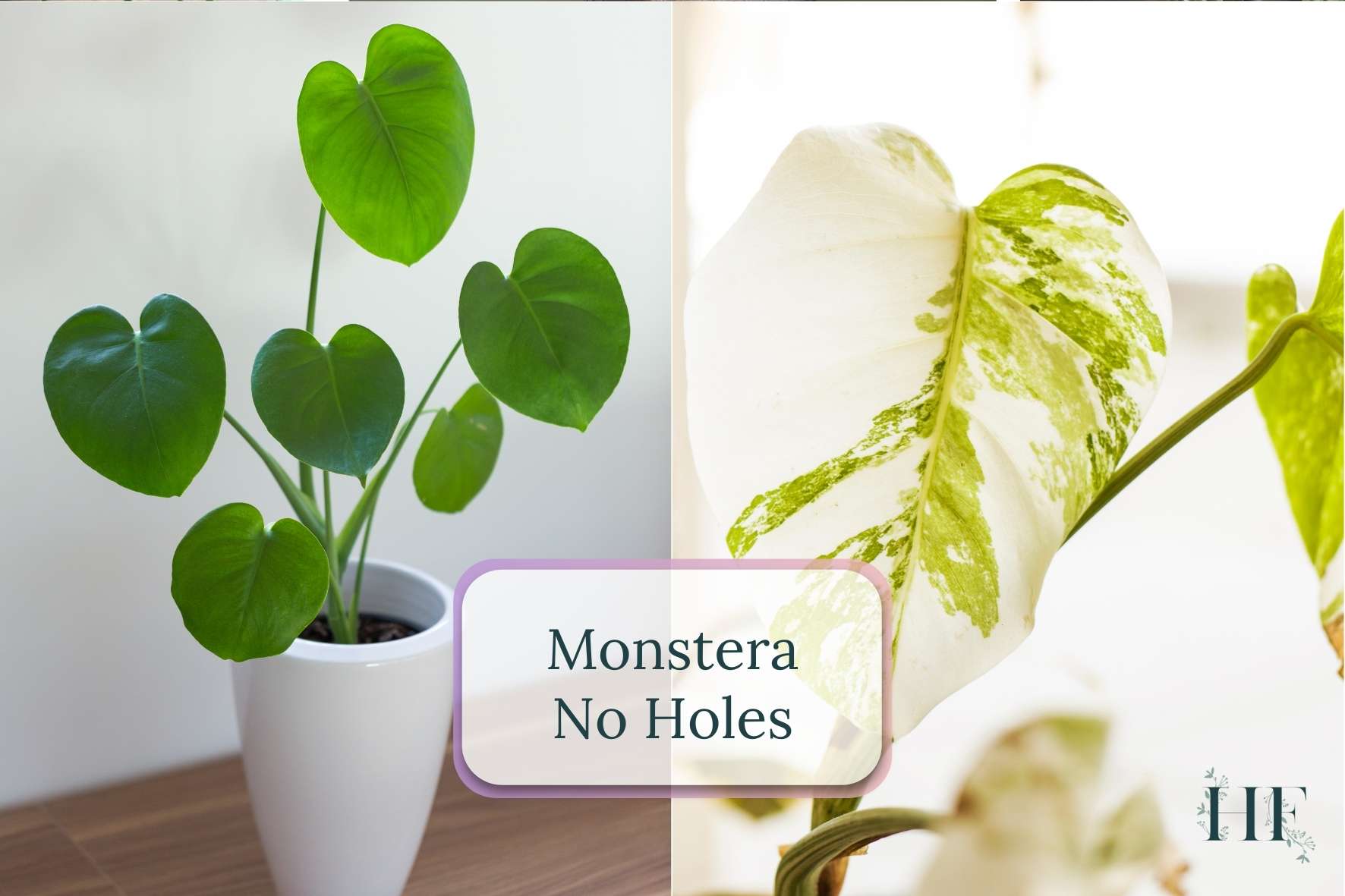
Are Monstera Leaves Poisonous?
The Monstera genus is toxic to humans and pets. All the parts of the plant, including the leaves and the unripe fruit in the case of Monstera Deliciosa, are toxic since they contain calcium oxalate crystals. These crystals are toxic if ingested and cause irritation to the touch.
Insider Tip: It’s best to handle your Monstera using gloves. Also, I always wash my hands after handling any houseplants, even if they are not toxic.
Read also: Is Monstera Toxic to Cats, Dogs and Babies? to learn more about the subject 😉
Monstera Fenestration
Let’s uncover a few more facts about this interesting phenomenon.
The word fenestration describes the splits and holes that Monstera plants get.
Monstera Deliciosa achieves its ultimate fenestrated leaf structure in stages. As the plant matures, the sizes of its leaves get bigger and those leaves develop more and more fenestration.
Monstera Fenestration Stages
The Monstera Deliciosa reaches fenestration milestones in this sequence:
Stage 1 – Solid Heart Leaf
A young Monstera plant has solid, heart-shaped leaves and no splits or holes. It looks just like another plant altogether!
Stage 2 – Side Slits
The Monstera Deliciosa plant first starts to show cuts along the edges of its leaves – splits. The shape of each individual leaf remains the same.
Stage 3 – Primary Midrib Holes
The leaves start forming holes in them, alongside the splits. The holes develop in parallel lines along the midrib.
Stage 4 – Secondary Midrib Holes
The first series of holes are soon followed by another line of holes parallel to the lateral veins of the leaves.
Stage 5 – Tertiary Midrib Holes
The final set of holes develops, closest to the midrib of the leaf. This marks the final stage of maturity of the Monstera leaf.
The entire fenestration process takes between 4 to 6 years.
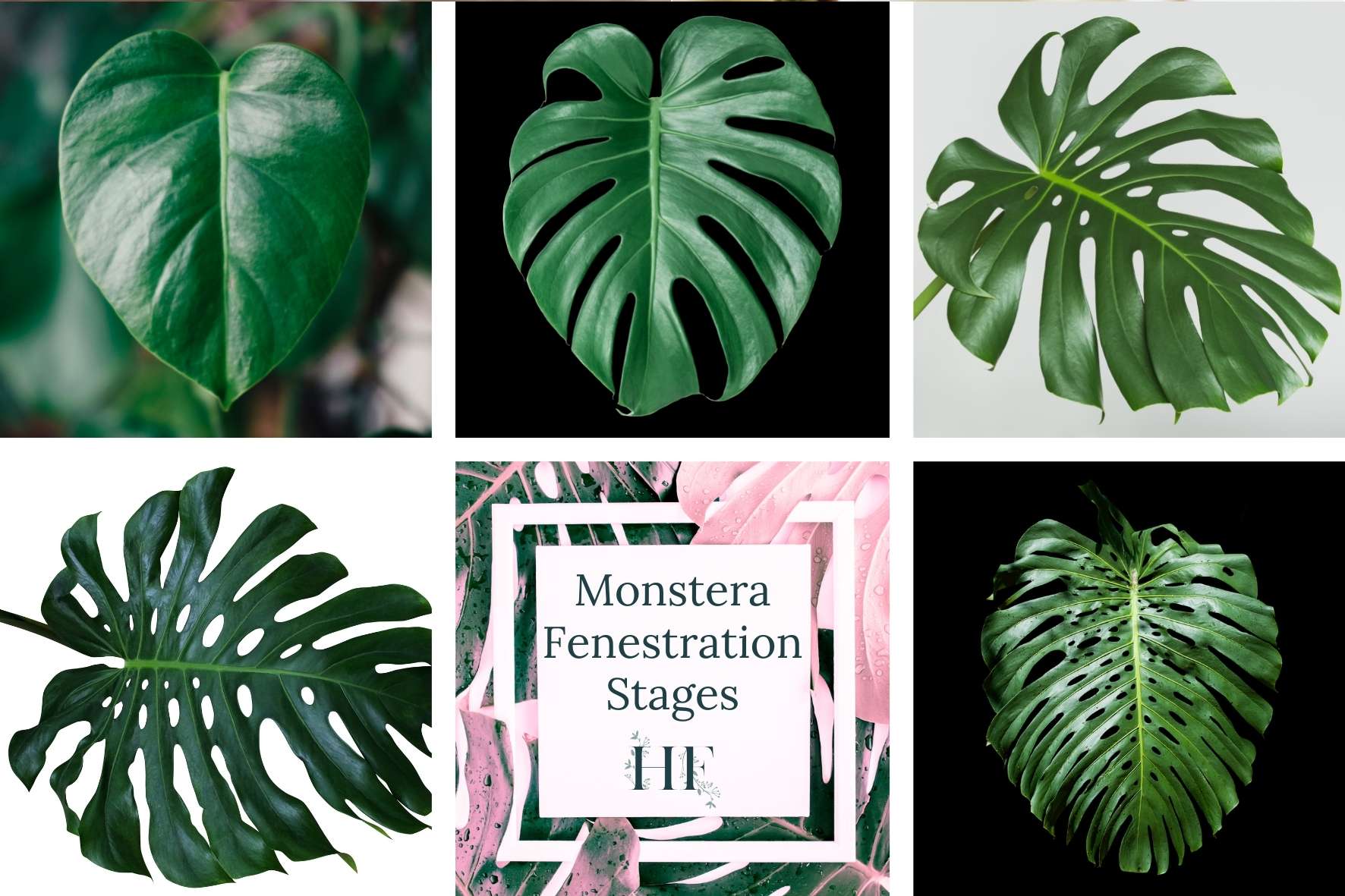
6 Tips to Encourage Fenestration in Monstera
How do you encourage fenestration in Monstera?
Split leaves are a coveted characteristic of Monstera plants. So, here are some tips that you can put into practice to ensure your plant achieves those split leaves whilst growing a healthy plant:
1) Place Your Monstera in a Spot with Bright, Indirect Sunlight
Light ranks first among all the factors that encourage fenestration on a Monstera.
If your Monstera is not fenestrating, slightly increasing your Monstera’s sunlight intake may be enough to help it along.
Make sure you place your Monstera plant in a well-lit spot, ideally near a window. You can easily achieve this by choosing a south-facing or east-facing window (a north-facing window being the least ideal due to little light and colder temperature). You want indirect sunlight instead of direct sunlight, to avoid sunburn and the leaves of your plants scorching, looking crispy and brown.
Signs of poor lighting include pale to yellowish leaves and your plant failing to grow new leaves.
If the natural light is not enough or your natural light options are limited, you can supplement the amount of light your Monstera gets by placing it under a grow light.
Your Monstera should get 12 hours of sunlight (daylight hours). If it’s only getting 6 hours of sunlight, you supplement the other 6 hours using a grow light.
Grow lights are especially useful in winter too, since your Monstera probably won’t be getting enough light and will be in need of an extra boost.
They come in different styles and can accommodate a whole host of sizes and space limitations. This full-spectrum grow light comes with a timer and you can clip it to a shelf. If you already have a lamp, you can get a Sansi bulb, which is affordable and does the job.
Insider Tip: Grow lights must be a full-spectrum fluorescent lights since the regular incandescent bulbs don’t emit the quality of light these plants need to photosynthesize.
Also, pay attention to the distance between the plant and the artificial light source. The light system should provide you with some guidelines for this.
Finally, remember that artificial lights produce heat and heat affects the humidity levels of your plant.
For more about light needs and placing your Monstera in a prime location, check Monstera Light Requirements – How Much Does It Need? blog post.
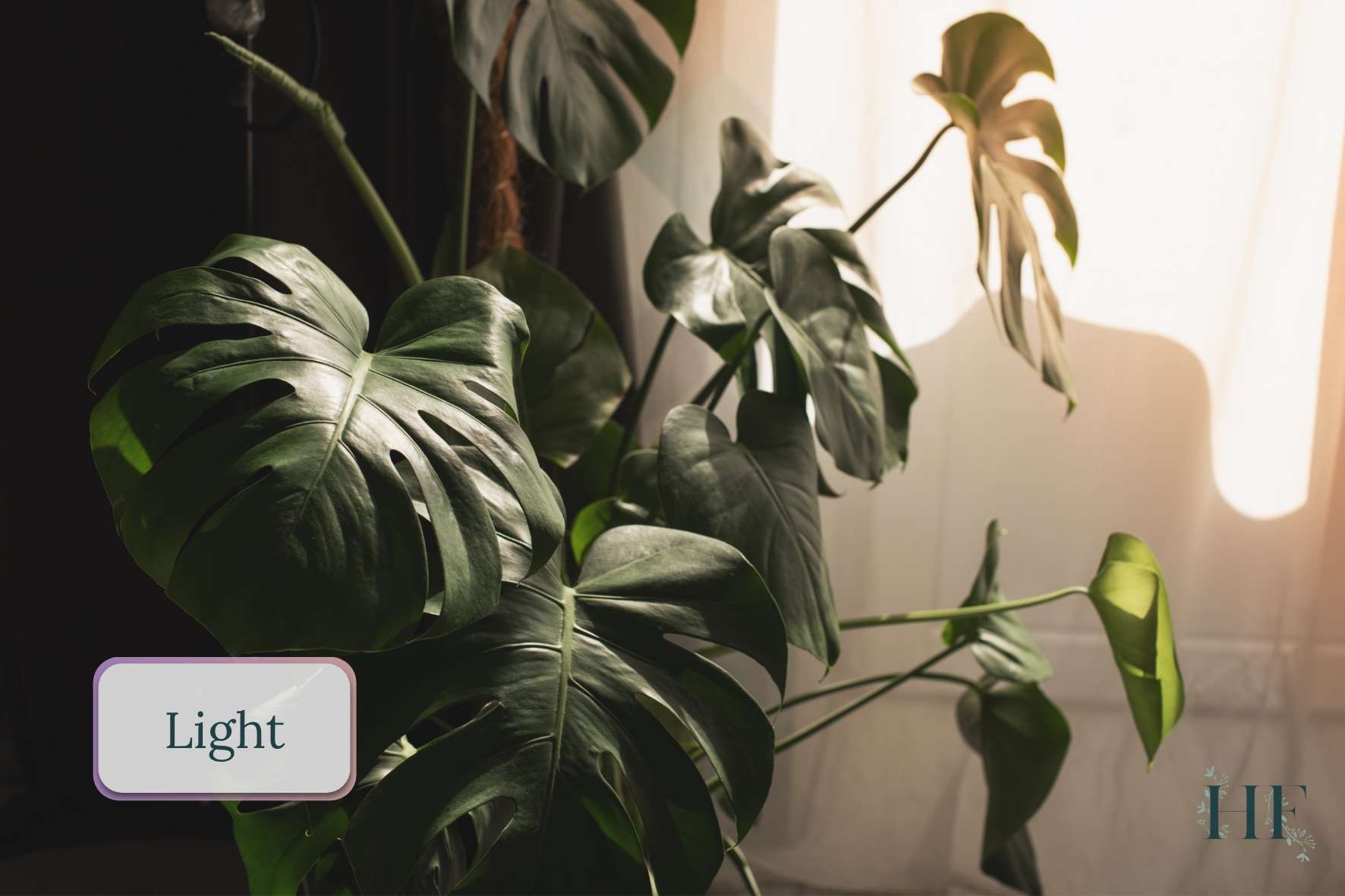
2) Water Your Monstera Consistently Once a Week
As a tropical plant, Monstera loves water. This is no surprise if you consider the heavy rains the rainforests experience during most of the year.
As a guideline, water your Monstera every once a week and in the morning to keep up with its water requirements like in their natural habitat. Also, avoid leaving the soil to dry out completely.
Waterings should be thorough so that the water completely saturates the soil, and any excess water should be drained from the saucer to avoid the plant sitting on water and causing rot.
However, a once-a-week schedule might not be enough depending on where you live, so you can find out if your Monstera needs water using a soil moisture meter. You can water your Monstera when the reading of the soil meter is at 2 or 3.
Insider Tip: If you are unsure if your plant needs water, you can also stick your finger on the soil to test how wet or dry it is before watering.
Finding the right balance might take a while, but it will impact your plant’s growth and health. Personally, I care for my houseplants on Sundays. This means I check if they need water and only water them if they do. During the summer months (or on especially hot days), I also check my plants mid-week to make sure they are coping okay with the heat.
Read also: A Guide to Monstera Water Needs (How Often and When).
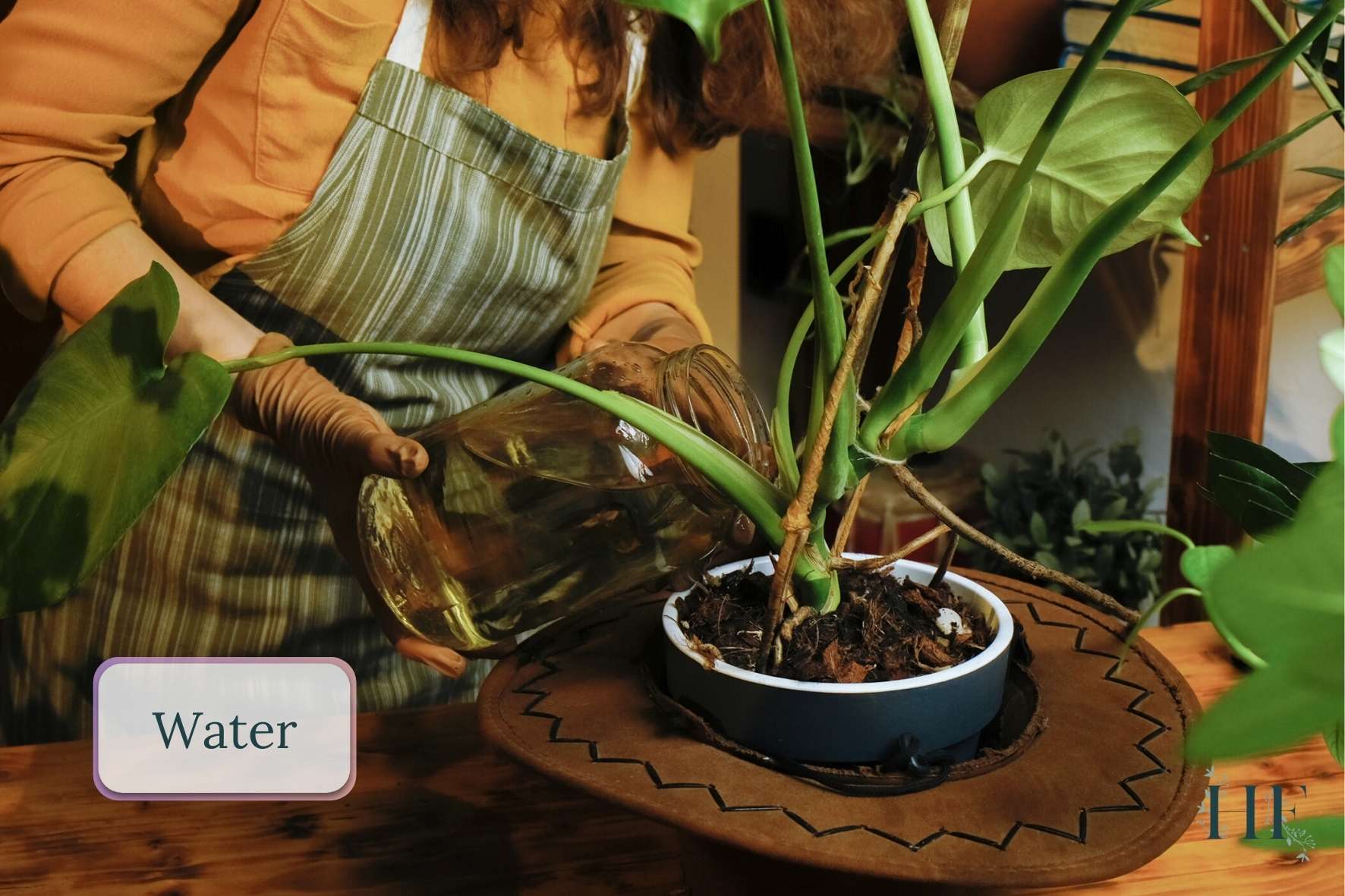
3) Feed Your Monstera with a Fertiliser
Monstera needs nutrients just like any other houseplant.
Fertilizing is a way of ensuring that your Monstera is getting enough nutrients. How often you fertilise your Monstera will depend on the seasons.
You can fertilise your Monstera once a month to keep the nutrients going during spring and summer. But, it’s best to cut off the fertiliser during autumn and winter, since this is the time when your plant is mainly dormant.
Insider Tip: Monsteras should be fertilised with a balanced fertiliser diluted in water. Follow the steps on the product label to avoid burning your plant. When available, I prefer using an organic fertilizer like this one.
Also, it’s best not to fertilise your Monstera after repotting it, as the slow-release nutrients that the soil has are enough for your plant as it settles in for the first 4 to 6 months. You can resume your fertilising routine afterwards.
Read also: A Guide to Monstera Nutrients (Why, When and How to Fertilise).
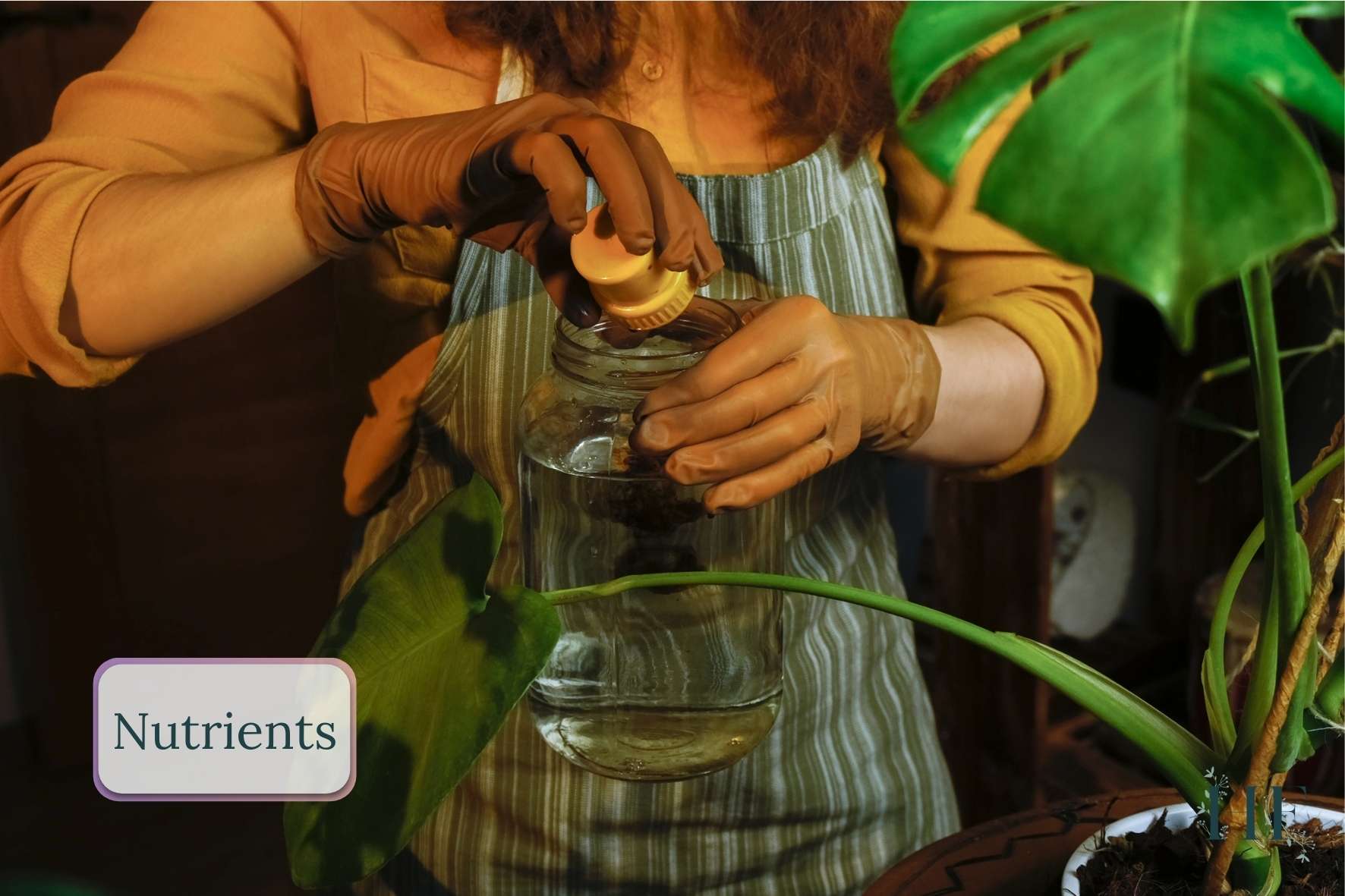
4) Provide Your Monstera With Appropriate Humidity Levels
Generally, Monstera thrives well in both medium to high humidity (40% to 60%) and warm temperature conditions (20 to 30°C or 68 to 86°F). The closer you try to mimic these conditions, the better for your plant.
In an ideal home, a Monstera will absolutely thrive in a well-lit bathroom. This area gets plenty of humidity throughout the week, so you won’t need to compensate for the lack of humidity.
If that is not an option for you, there are a few ways of ramping up the humidity of the room where you plant is:
- Install a humidifier (with timer and humidity sensor) – the most efficient way to raise the humidity levels.
- Place a tray of pebbles with water near the plant or turn your Monstera’s saucer into a pebble tray – not as effective.
- Mist your Monstera a couple of times a week – also, not as effective as the humidifier since the effect is short-lived. You can use a glass minster like this one.
Find more tips about how to increase Monstera humidity levels here.
Insider Tip: If you decide to use a humidifier or mist your Monstera plant, it’s best to do it in the morning so you allow enough time for the leaves to dry out.
Finally, be sure to keep Monstera plants away from the heating and air-conditioning.
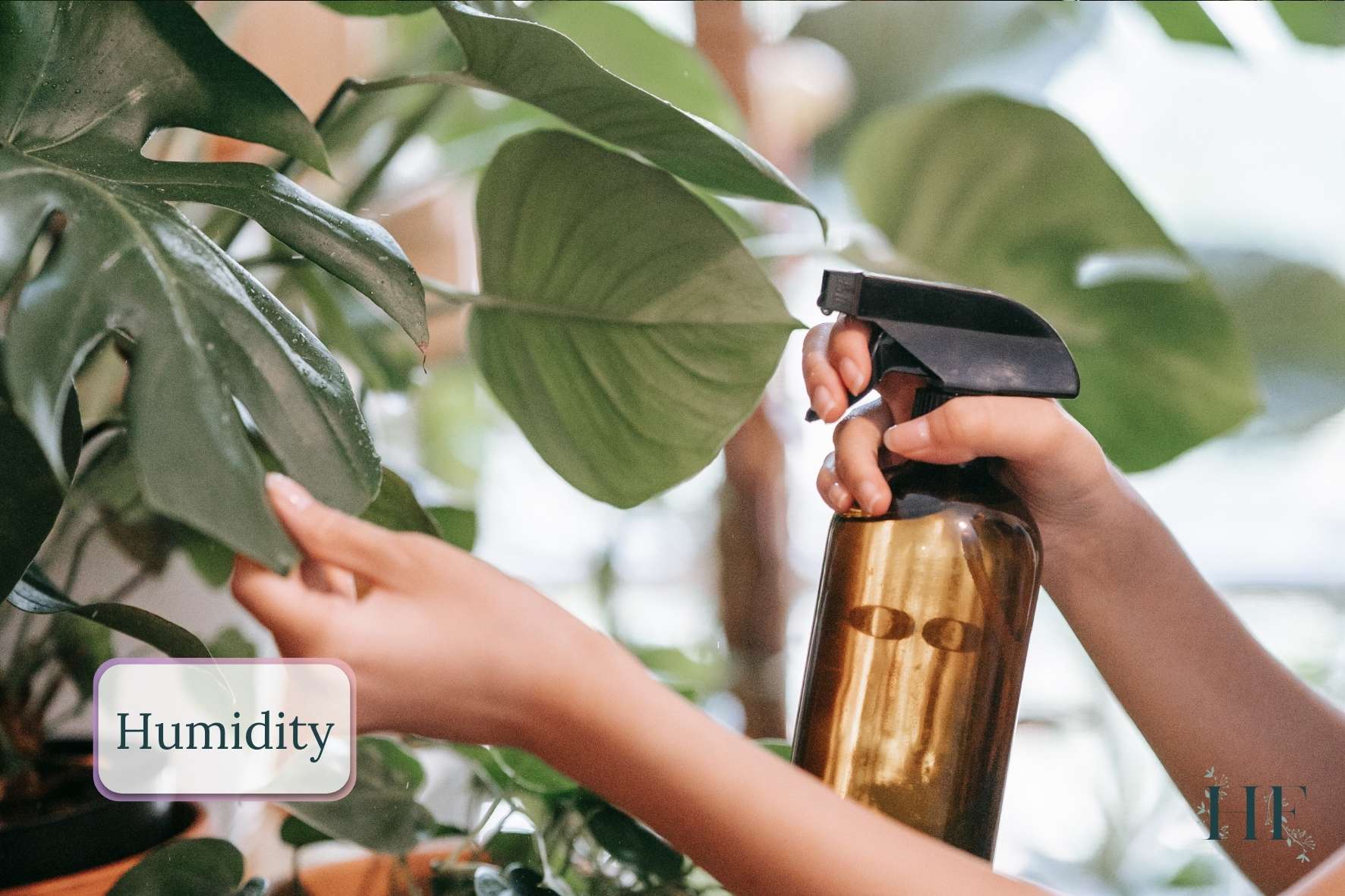
5) Consider Repotting Your Monstera Every 2 Years
A Monstera plant should be repotted at least every two years to ensure adequate soil nutrition and space for the plant to grow. The roots will be significantly affected if they don’t have enough space to stretch.
Also, spring is the best season to repot your Monstera plant. This is when the plant stops being dormant and starts to produce new growth.
Here’s how you know your Monstera needs repotting:
- When it is root-bound – meaning the roots are formed into a dense, tangled mass that allows little or no space for further growth.
- The roots are pocking out from the bottom of the pot.
- Your Monstera shows no signs of new growth.
For these reasons, repotting Monstera is absolutely necessary.
Insider Tip: When repotting your Monstera, choose a slightly larger pot than the previous one, instead of jumping into a significantly bigger one. When the pot is too large, it can cause the soil to retain excess water, leading to root rot. I usually go two sizes bigger. For instance, from a 13cm diameter pot to a 15cm one.
It’s also important that repotting be done with fresh soil. This reduces the risk of cross-contamination and introduces fresh nutrients to the plant, which is vital for encouraging growth.
Read also: A Guide to Repotting Monstera (When, Why and How).
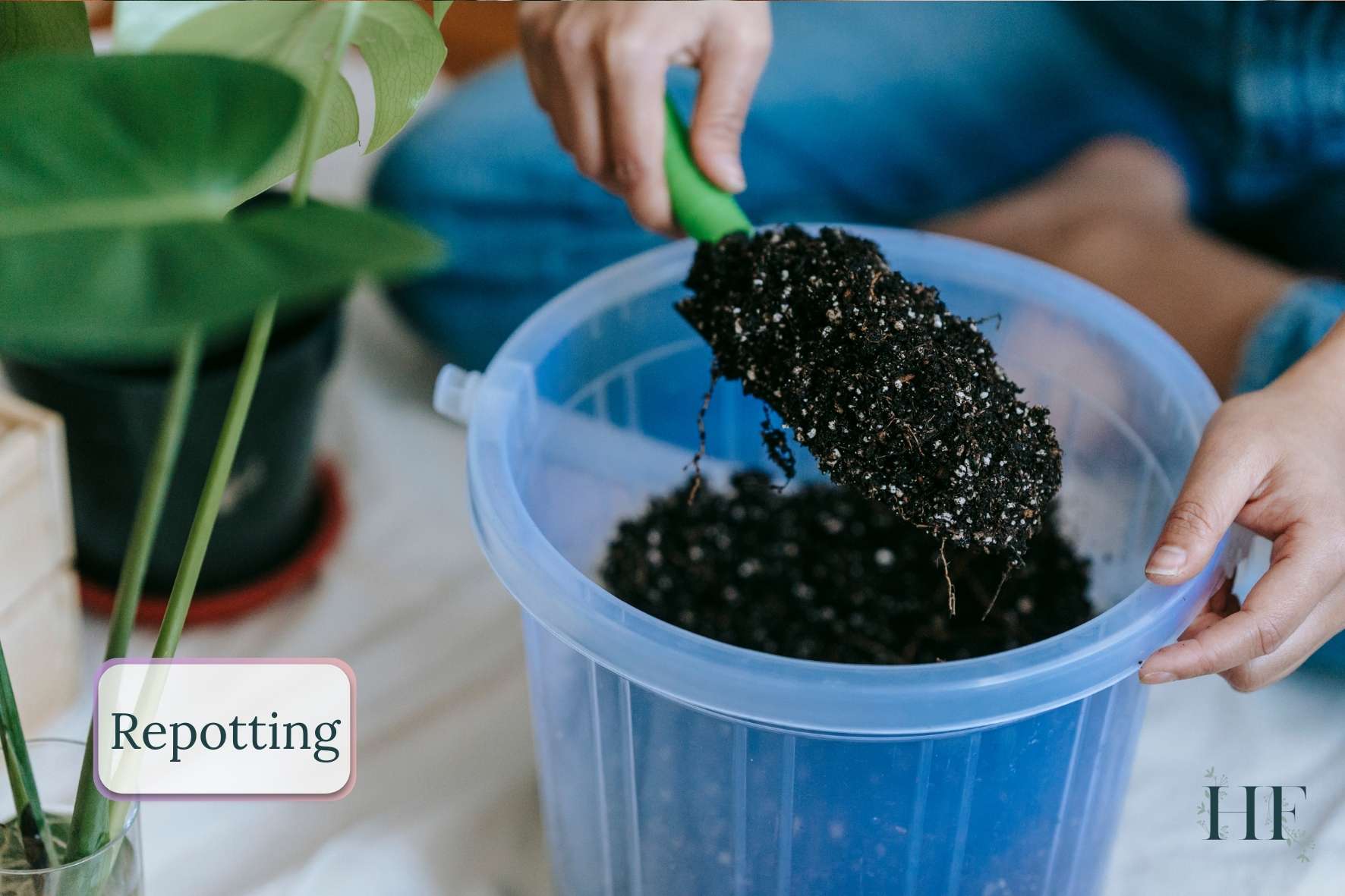
As a side note, when repotting you might want to consider how to support your climbing Monstera. A support system that allows your Monstera to climb will help the leaves to split sooner.
Here are some Monstera support ideas:
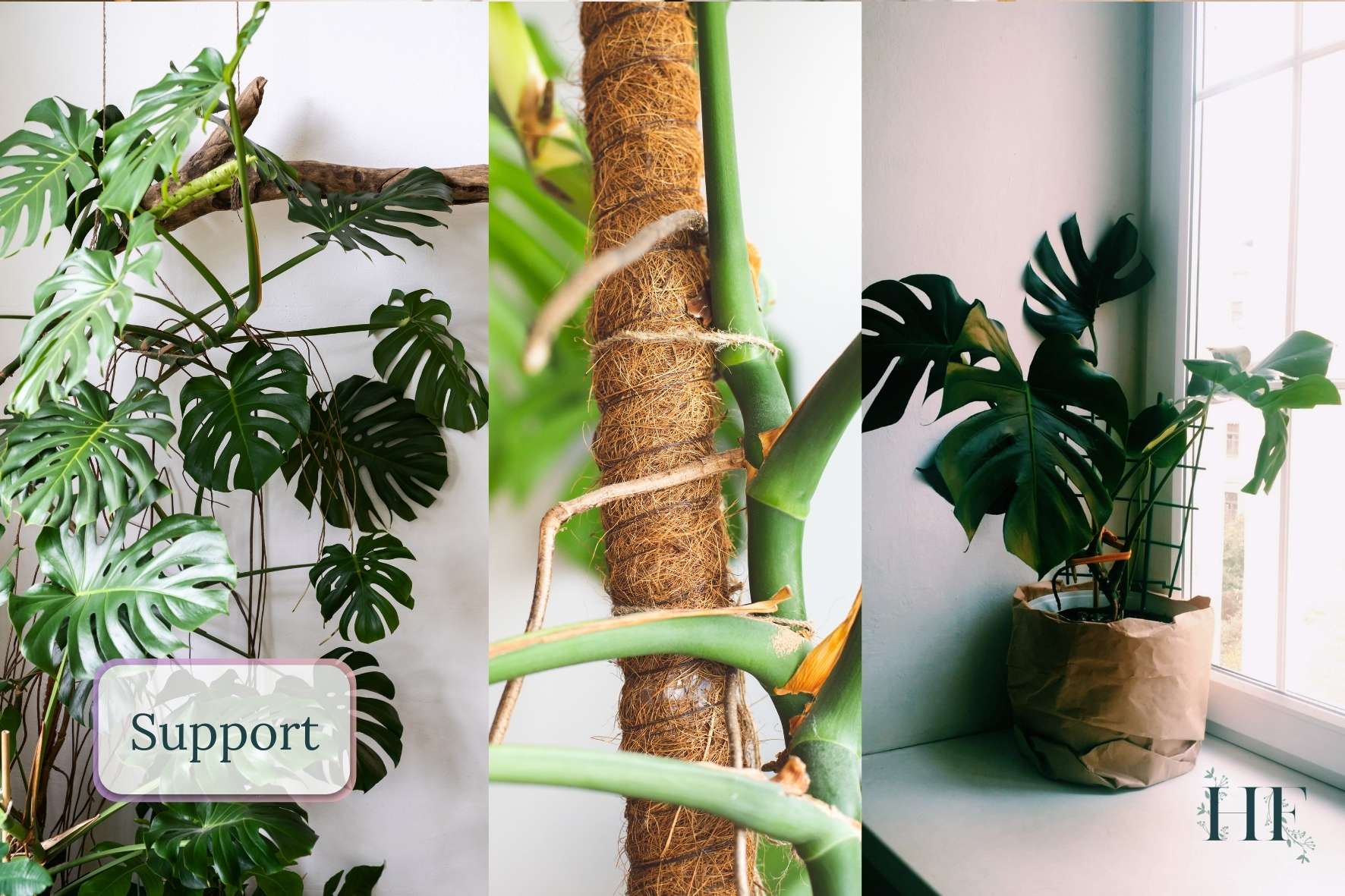
6) Prune Your Monstera’s Damaged Leaves
Pruning is vital to encourage growth in any plant.
In the case of Monsteras, pruning any damaged leaves can help your plant develop fenestrations. Removing those leaves will allow the plant to allocate its resources elsewhere and encourage it to put out new growth that will be more likely to have fenestrations.
Pruning should be done in the early spring before the growing season starts. When pruning, make a clean cut at an angle, avoiding crushing the tissue around the cut. Also, cut off just the leaf itself, leaving this stalk intact so that your Monstera’s new growth can continue to develop.
Before pruning your Monstera, identify what leaves need to be taken off:
- Scorched or brown leaves.
- Yellow leaves.
- Scarred leaves.
All you need is a pair of sanitized, sharp shears (or scissors) and a clear understanding of where to cut.
Read also: A Guide to Monstera Pruning (How, When and Why).
